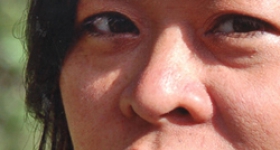In our tenth anniversary issue, writer and historian Rachel Schreiber tells the story of an interracial relationship during World War II. Elaine Black Yoneda, a Jewish American woman, and her husband, Karl Yoneda, were both interned at the Manzanar internment camp. Here, Schreiber discusses about some of the violence the couple faced during their imprisonment, revealing the little-known story of a gang at Manzanar, the Black Dragons.
Throughout their time at the Manzanar War Relocation Center Elaine, Karl, and Tommy Yoneda were subjected to violence and threats by a gang at the camp. The Manzanar Black Dragons, a group of mostly Kibei (Japanese Americans born in the U.S. but educated in Japan), formed in early May 1942. While some Japanese Americans, including Karl, pledged allegiance to the United States, others, including these gang members, were highly critical of the U.S. government. Japanese Americans were Americans, after all, many of whom had been in this country for generations. In the process of internment, the U.S. government violated its citizens’ rights, seized their property, and incarcerated people against their will. Gang members demonstrated their resistance to such policies by acts of violence and other activities in the camp.
The Manzanar Black Dragons drove around the camp in a trash truck decorated with a black and white skull-and-crossbones flag. They distributed leaflets urging Nisei to discontinue work in aid of the U.S. military—such as the work Elaine was doing in helping to produce camouflage netting for the Army. Expressing their allegiance to Japan, they threatened physical violence against anyone demonstrating loyalty or aid to the United States.
By August 1941, a rumor circulated that the Black Dragons had formed a “death list,” on which the Yonedas figured prominently. On August 20th, Elaine saw a man named Uyemoto speaking with some teenage boys near where she was working on the camouflage nets. Uyemoto had been nicknamed “General Araki,” because he had been wearing a mustache similar to that of the right-wing nationalist Japan War Minister. On this day, Elaine noted, “General Araki” had re-fashioned his mustache to mimic that of Adolf Hitler. After he walked away from the boys, they began to throw rocks at Elaine and the other workers. Elaine was injured, and she and Karl filed one of their many reports protesting this intra-camp violence. The authorities appeared indifferent.
When the Army recruiters came to Manzanar and accepted a number of internees into the American military, the Black Dragons were incensed. Shortly after Karl’s departure from Manzanar on December 2 for training camp in Minnesota, the situation became explosive. On December 5 and 6, the camp was the site of extreme violence between Kibei protestors and members of the Japanese American Citizens’ League. The Military Police became involved, and eventually shot and killed a 17-year old boy. In what became known as the Manzanar Riot, the instigators pledged to harm the families left behind by the enlisted men. Once again, Elaine entreated the authorities to allow her and Tommy to leave the camp. Her pleas finally came to fruition as camp authorities tried to tamp down the violence. On December 7, Elaine and Tommy were removed from the camp to a nearby Military Police Encampment. From there, Elaine and Tommy left, returning home to San Francisco on December 16, 1942.
The Manzanar Black Dragons provide evidence of resistance against the United States’s crimes against Japanese Americans during World War II. Though the Dragons’ violence is reprehensible, their impulse to question their incarceration is indeed understandable. In some ways, the fact that Japanese Americans such as Karl Yoneda enlisted in the very military that incarcerated them is more confusing. It is also probably surprising to many contemporary readers to learn that, though they worked throughout their post-War lives to ensure that the memory of Japanese internment would never be forgotten, neither Elaine nor Karl ever criticized the U.S. government for its actions. With hindsight, it’s easy to judge Karl and Elaine’s unwavering patriotism. But like the Black Dragons, Karl was also standing by his beliefs—as a Communist, he was passionately anti-Fascist and therefore supported the Allies’ efforts to defeat the Nazis. And though the Black Dragons’ indignation at American authorities was certainly warranted, their political commitment to imperialism, and their idolization of figures such as Araki and Hitler, paints a complex ideological landscape of the internment camps.
Historical memory has a tendency to oversimplify the narrative of the past, particularly that of wartime. But for those living through the World War II era, it was a confusing time during which it was not always simple to distinguish right from wrong. Understanding the nuances of the beliefs and actions of the Yonedas and the Black Dragsons ultimately raises new questions that still resonate today: to what ideologies do we ascribe, whether through action or inaction? And what do we resist?
To read more about Elaine and Karl's World War II love story, subscribe to Hyphen or pick up a copy of The Generation Issue at a newsstand near you.









Comments